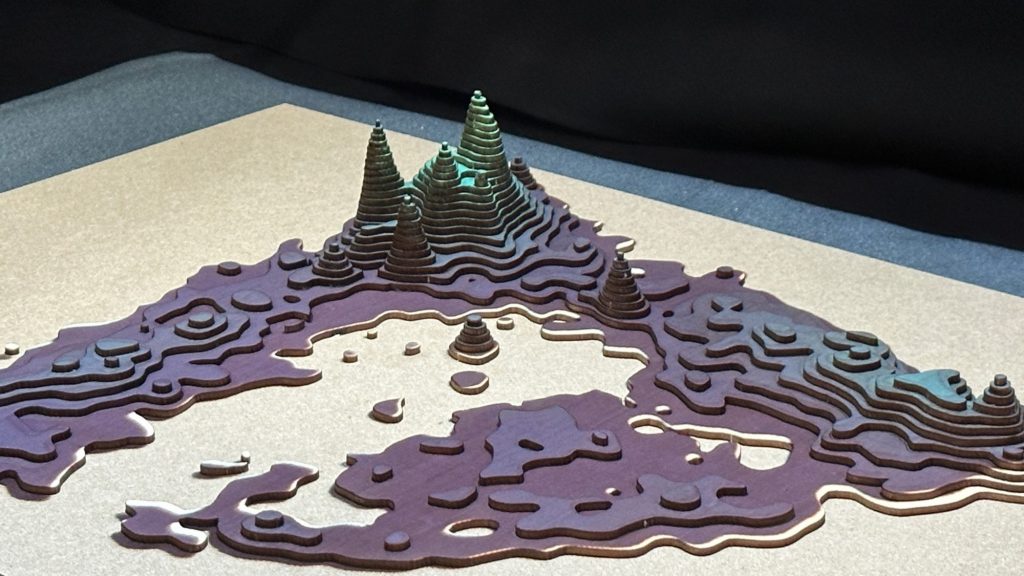Loneliness is not on the mountain but on the street, not within one person but among many people. — Kiyoshi Miki
Loneliness and isolation are emotions that have accompanied humanity throughout history. Even in today’s world, with social media offering multiple ways to connect and share our feelings, the sense of loneliness persists. The irony? Despite having these tools at our disposal, our cries for connection often disappear into the vast sea of digital content.

In our art project recently exhibited at ChinaVISAP’24 hosted at HKUST, we took a closer look at posts from people who shared their loneliness during the holidays, yet received little or no response. To bring these unheard voices to light, we combined digital data with physical models, creating what we call the “Island of Loneliness.” Through this project, we aim to highlight the complexity of human emotions in the digital age and provoke thought about how technology, loneliness, and social interaction intertwine.

This art piece has been exhibited in IEEE VISAP (Melbourne, Australia, 2023), Info+ (Edinburgh, UK, 2023), and ChinaVisap (Hongkong, China, 2024).
In this post, we’re excited to share the story behind our art project and the ideas that inspired it. If you’re curious about the design process, you can dive into our published pictorial, and we’ve also provided some supplemental materials on OSF.
Our team consists of visualization researchers with a passion for data storytelling, data-driven art, and text visual analysis. We’re regular contributors to IEEE VIS, which is a leading academic conference in data visualization. One of the highlights of this conference is the VIS Arts Program (VISAP), a unique event where visualization researchers, designers, and artists come together to explore the intersection of data visualization, art, and design. We’ve always been fascinated by this event and have wanted to be a part of it.
Our journey with this project began back in 2021, when the theme of IEEE VISAP was “dis/connected” and ChinaVisap’s theme was “bridge-connection.” These themes sparked an intriguing thought: What if there were no connections between people? Social media links people across different places and times, forming a vast network. But what happens when these connections break down? Each person becomes an isolated “lonely island.” What stories do these islands hold? What narratives emerge from this solitude?
Although we didn’t start the project right away due to other commitments, the idea lingered with us, especially as some of us experienced feelings of isolation within this vast digital network—what we often describe as “loneliness.” Fast forward two years to 2023, and the theme of IEEE VISAP was “Perpetual Presence.” This theme felt like a call to action, reigniting our idea. These “islands” on social media, where people’s voices go unheard, are a form of perpetual presence in digital world—a blend of human behavior, emotion, and modern digital technology.
That’s when we began.
Initially, we were drawn to social media posts that received no replies, no reposts, and no likes. But we soon realized there were far too many such posts. So, we narrowed our focus to those expressing loneliness. The lack of responses to these posts only deepened the sense of isolation, compelling us to draw attention to these silent voices and highlight their existence and significance.

We used the metaphor of an island to illustrate our visualization. Imagine the data stream as a vast sea, where people cast their thoughts and emotions like stones. Some stones are significant and create ripples, while others are small and go unnoticed, sinking to the seabed like grains of sand. Over time, these unnoticed posts accumulate and form an island, rising from the depths of the sea to the surface.
The ripples on the water’s surface contrast with the silent accumulation of stones below, much like how lively discussions in popular online spaces stand in stark contrast to the unnoticed self-expressions in quieter corners. We combined physical models and digital projections to bring this contrast to life.
For our project, we gathered some real tweets expressing loneliness during Christmas. Each one is a snapshot with its own complete emotion and story.

We also explored data from Weibo. The data is rich, reflecting the complexity of social media dynamics and the various reasons people share their personal experiences.

Chinese text, which can convey a lot in just 140 characters, adds another layer of depth. People tend to get emotional late at night, which can reveal underlying emotional issues that might need attention. Yet, when private emotions are too closely monitored and analyzed, it can feel unsettling—almost eerie—due to the invasive nature of technology. Even though some of us specialize in visual analysis and data storytelling, we remind ourselves that this is an art installation, not a visual analysis system for social media data. Therefore, we kept a balance of analyzing specific words and presenting loneliness from these texts. We weakened the texts in our final installation, instead, we summarized them into the physical “island” visualization of loneliness.

It is important to note that not all posts without responses should be viewed as isolated cases. We’re still exploring whether those expressing loneliness are truly seeking interaction, or if some people simply find comfort in solitude. Human nature is complex, and social media posts can reflect both a desire for connection and a wish for privacy.
As our project evolves, we’re expanding our data collection across more platforms to create larger “Islands of Loneliness.” Through this, we hope to not only listen to these unspoken voices but also build meaningful connections and provide support to those who might need it. Additionally, we plan to broaden our scope to include a wider range of topics that often go unnoticed.
– By Junxiu Tang (Zhejiang University), Rui Sheng (HKUST), Yifang Wang (Northwestern University), Xinhuan Shu (Newcastle University)
Views: 419
Go Back to page Top
- Category:
- Guest Posts
- HKUST Research
Tags: Data Art, data visualization, Loneliness, Physical Visualization, Social Media
published August 28, 2024


